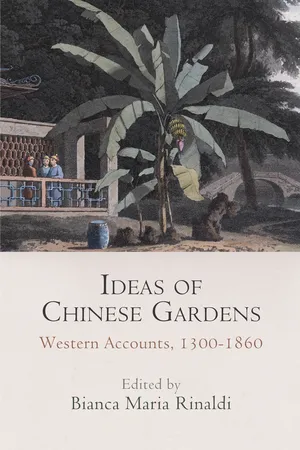
- 384 pages
- English
- PDF
- Available on iOS & Android
About This Book
Europeans may be said to have first encountered the Chinese garden in Marco Polo's narrative of his travels through the Mongol Empire and his years at the court of Kublai Khan. His account of a man-made lake abundant with fish, a verdant green hill lush with trees, raised walkways, and a plethora of beasts and birds took root in the European imagination as the description of a kind of Eden. Beginning in the sixteenth century, permanent interaction between Europe and China took form, and Jesuit missionaries and travelers recorded in letters and memoirs their admiration of Chinese gardens for their seeming naturalness. In the eighteenth century, European taste for chinoiserie reached its height, and informed observers of the Far East discovered that sophisticated and codified design principles lay behind the apparent simplicity of the Chinese garden. The widespread appreciation of the eighteenth century gave way to rejection in the nineteenth, a result of tensions over practical concerns such as trade imbalances and symbolized by the destruction of the imperial park of Yuanming yuan by a joint Anglo-French military expedition.In Ideas of Chinese Gardens, Bianca Maria Rinaldi has gathered an unparalleled collection of westerners' accounts, many freshly translated and all expertly annotated, as well as images that would have accompanied the texts as they circulated in Europe. Representing a great diversity of materials and literary genres, Rinaldi's book includes more than thirty-five sources that span centuries, countries, languages, occupational biases, and political aims. By providing unmediated firsthand accounts of the testimony of these travelers and expatriates, Rinaldi illustrates how the Chinese garden was progressively lifted out of the realm of fantasy into something that could be compared with, and have an impact on, European traditions.
Frequently asked questions
Information
Table of contents
- COVER
- TITLE
- COPYRIGHT
- CONTENTS
- INTRODUCTION
- CHAPTER 1 MARCO POLO (C. 1254–1324)
- CHAPTER 2 MATTEO RICCI (1552–1610)
- CHAPTER 3 ÁLVARO SEMEDO (1585/1586–1658)
- CHAPTER 4 JOHANNES NIEUHOF (1618–72)
- CHAPTER 5 JEAN-FRANÇOIS GERBILLON (1654–1707)
- CHAPTER 6 LOUIS LE COMTE (1655–1728)
- CHAPTER 7 JEAN-FRANÇOIS GERBILLON (1654–1707)
- CHAPTER 8 MATTEO RIPA (1682–1746)
- CHAPTER 9 JEAN-DENIS ATTIRET (1702–68)
- CHAPTER 10 WILLIAM CHAMBERS (1723–96)
- CHAPTER 11 JEAN JOSEPH MARIE AMIOT (1718–93)
- CHAPTER 12 JOHN BELL (1691–1763)
- CHAPTER 13 MICHEL BENOIST (1715–74)
- CHAPTER 14 FRANÇOIS BOURGEOIS (1723–92)
- CHAPTER 15 CARL GUSTAV EKEBERG (1716–84)
- CHAPTER 16 PIERRE-MARTIAL CIBOT (1727–80)
- CHAPTER 17 JEAN JOSEPH MARIE AMIOT (1718–93) OR PIERRE-MARTIAL CIBOT (1727–80) (ATTRIBUTED)
- CHAPTER 18 PIERRE-MARTIAL CIBOT (1727–80)
- CHAPTER 19 PIERRE-MARTIAL CIBOT (1727–80)
- CHAPTER 20 GEORGE LEONARD STAUNTON (1737–1801)
- CHAPTER 21 ANDRÉ EVERARD VAN BRAAM HOUCKGEEST (1739–1801)
- CHAPTER 22 JOHN BARROW (1764–1848)
- CHAPTER 23 GEORGE MACARTNEY (1737–1806)
- CHAPTER 24 CHRÉTIEN-LOUIS-JOSEPH DE GUIGNES (1759–1845)
- CHAPTER 25 FÉLIX RENOUARD DE SAINTE-CROIX (1767–1840)
- CHAPTER 26 PETER DOBELL (1772–1852)
- CHAPTER 27 JAMES MAIN (C. 1765–1846)
- CHAPTER 28 JOHN FRANCIS DAVIS (1795–1890)
- CHAPTER 29 ROBERT FORTUNE (1813–80)
- CHAPTER 30 OSMOND TIFFANY Jr. (1823–95)
- CHAPTER 31 HENRY CHARLES SIRR (1807–72)
- CHAPTER 32 ROBERT FORTUNE (1813–80)
- CHAPTER 33 CHARLES TAYLOR (1819–97)
- CHAPTER 34 ROBERT SWINHOE (1836–77)
- CHAPTER 35 GARNET JOSEPH WOLSELEY (1833–1913)
- APPENDIX: WILLIAM CHAMBERS (1723–96)
- BIBLIOGRAPHY
- INDEX
- ACKNOWLEDGMENTS